Essential for fish nutrition
Fishmeal and fish oil are the foundation of formulated aquafeeds thanks to the superior nutrition that they provide and are regarded as the nutritional benchmark for other ingredients.
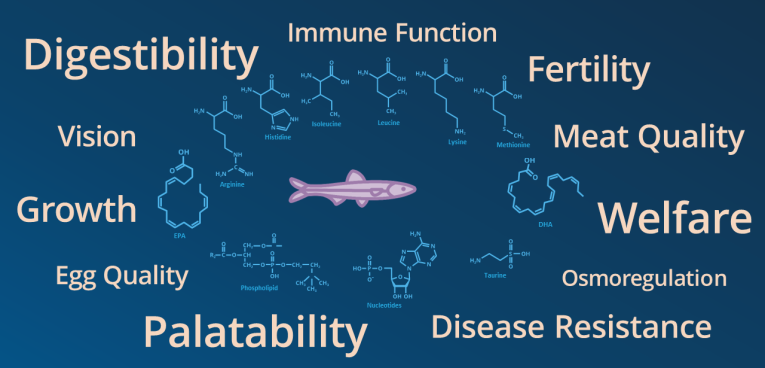
The production rates for both ingredients has remained steady for over the past 25 years indicating stability in supply (and consequently no additional pressure on fisheries despite continual aquaculture growth). There is growth in the utilisation of by-products as raw material, but the availability is not enough to match the growth of aquaculture. Aquaculture itself will also provide additional byproduct for fishmeal and fish oil production in the future.
Fishmeal and fish oil carry with them decades of data and information about raw material supply, production, nutrient profile and other detail. With comparatively high protein levels (usually 68-72%), high digestibility (often 90% or more), perfectly profiled amino acid and fatty acid balances, and a range of micronutrients including vitamins and minerals that are essential for heath and growth, fishmeal and fish oil are benchmark aquafeed ingredients against which the performance of other ingredients are measured. They are a known factor in the feed industry, which is not the case with other raw materials. Additional ingredients are being developed alongside fishmeal and fish oil to provide optimal fish nutrition and ensure the continued growth of the aquaculture industry.
Feeding fishmeal/fish oil has been shown to have the following advantages for animal health, welfare and productivity:
- Improved immunity greater disease resistance and reduced impact of disease (if contracted).
- Reduced mortality in younger animals
- Reduce severity of inflammatory diseases (EPA and DHA are anti-inflammatory).
- Provide a wide range of essential nutrients, many of which are not provided adequately from vegetable materials, thus improving the animal's nutritional status.
- Improved productivity through better growth and feed conversion, thereby reducing the cost of animal production (although feed cost in some cases may increase slightly, this is offset by the reduced unit cost of producing the animal).
It starts with palatability
Intake and palatability, remain the first and most important hurdles and need to be monitored in both the short and long term due to effects on metabolism and life stages. When feed diets are formulated using different ingredients, for whatever species, it is largely a process of matching the nutrient composition of the ingredient combination with the requirements of the animal being fed. Understanding the impacts the various ingredients used on palatability is key to their success and some ingredients, despite their excellent nutrient composition profiles, are well known to be poorly accepted by some species. Notably, palatability responses tend to become most prominent in the first couple of weeks. After that animals can compensate as longer-term nutritional drivers (e.g. hunger) begin to override the palatability side of things.
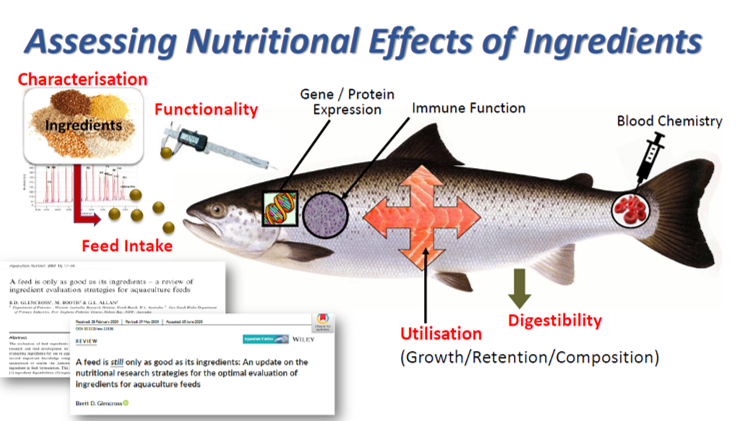
Both fishmeal and fish oil accentuate the palatability of feed and were used at much higher rates 30 years ago in the early years of aquaculture. Inclusion rates have now greatly reduced to now fishmeal and fish oil being used as a strategic and functional ingredient, with rates tailored to species specific needs.
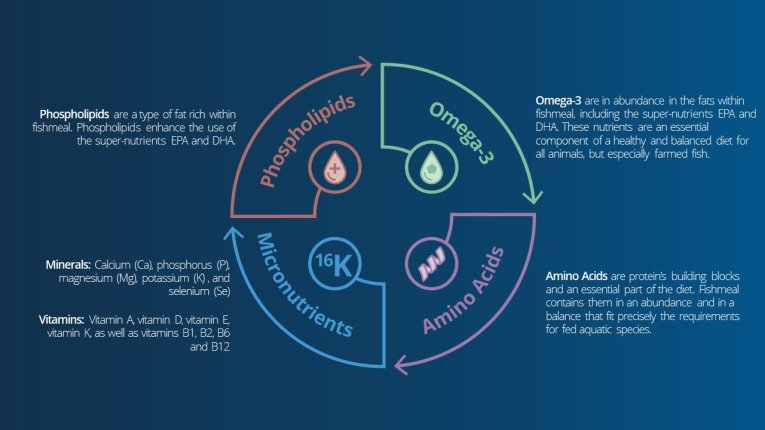
|
Find out more: |
Benefits of fishmeal to fish
Fishmeal is a balanced, highly digestible and palatable feed ingredient which is used at strategic stages of the production cycle of fish in support of growth and health. It offers a range of important nutrients for farmed fish, with the main nutrients being:
- Protein - arguably the most important nutrient in underpinning animal growth performance and fishmeal is among the best and most cost effective available ingredients for protein, with an abundance of amino acids that fit precisely the requirements for all fish species.
- Amino acids - Protein in animal bodies is made up of 20 amino acids and of those 20 amino acids,10 have to be supplied by the diet – they cannot be made. Fishmeal has an abundance of those essential amino acids.
- Phospholipids - a type of fat that forms the cell walls of most tissues and are rich in fishmeal and are biochemically novel in that they interact with both insoluble (fats) and soluble (proteins) parts of cells.
- Long chain omega-3’s (EPA & DHA) - Richer source than any other feed ingredient, barring fish oil itself (fishmeal usually contains 8-12% of fish oil), which is essential for overall good health and optimal growth
- Minerals - An excellent source of a number of nutritionally important minerals, including calcium and phosphorus (aids bone formation), magnesium, potassium, and selenium
- Vitamins – rich in vitamins, such as vitamin A (immune system), vitamin D (aids mineral absorption and bone health), vitamin E (nerve function), vitamin K (blood clotting), as well as vitamins such as B1, B2, B6 and B12
Looking beyond these nutrients, recent research has identified the following additional nutrients found in fishmeal:
- Marine osmolytes are naturally occurring organic or inorganic metabolites that help in cell volume regulation, osmotic homeostasis and protein stabilization which are fundamental to cell and organismal survival in marine life forms. Marine organisms evolved with specific osmolytes (such as methylamines eg. Trimethylamine oxide, TMAO) to protect against stressors of salinity, temperature, and hydrostatic pressure. Marine ingredients are thus prime sources of one or more of these osmolytes and thus integral to fish health in aquaculture, more so under challenging or critical production stages. Watch NOFIMA's Dr Antony Prabhu Philip for more insights.
- Nucleotides are the building blocks of nucleic acids like DNA and RNA and fishmeal is among one of the richest natural sources of nucleotides. They have been shown to stimulate both growth and the immune system in fish and crustaceans.
- Fish Protein Hydrolysates help stimulate feed intake and improve the resilience of fish to disease. Watch Professor Luisa Valente (University of Porto) for more insights.
- Additional unique compounds which have been linked to superior performance, and palatability, include taurine, trimethylamine oxide, nucleotides and glycosaminoglycans
|
Find out more:
|
Benefits of fish oil to fish
Fish oil is an essential component of a healthy and balanced diet for farmed fish. Just as they provide health benefits to humans, so do they provide health advantages for farmed fish. It offers a range of important nutrients for farmed fish, with the main nutrients being:
- Dietary source of energy and essential for overall good health and optimal growth
- Long chain omega-3 fatty acids such as EPA and DHA support physiological processes including cellular signalling, membrane function and hormone precursors
- Greatly enhances palatability of the feed – which is vital at the early stages of growth
Looking beyond these nutrients, recent research has identified the following additional nutrients found in fish oil:
- Marine-derived cetoleic acid is a type of fatty acid found in herring and capelin oils, it helps with improved retention of EPA and DHA in body tissues.
Fish oils are traditionally high in the lcPUFA omega-3 fatty acids like DHA and EPA (Figure 1). It is these DHA and EPA omega-3 fatty acids that have been linked to so many different positive features in human and animal health. While the scPUFA omega-3 has some positive benefits, it is only when they are bioconverted to the more biologically active DHA and EPA, and not all animals can make that conversion. In contrast the omega-6 fatty acids have been linked to inflammation and some negative aspects associated with human and animal health. We are now also seeing evidence that elevated levels of omega-6 in the diet can impact the benefits of the omega-3. So, it remains important to understand that not all omega-3’s are equal and the different omega’s have different roles.
Figure 1. The distinction between the short and long-chain omega-3 (blue) and omega-6 (red) fatty acids.
Figure 2. Critical distinctions between plant and fish fatty acid profiles shown by the abundance of lcOmega-3 in fish oils compared with the abundance of scOmega-6 and scOmega-3 in plant oils.
|
Find out more:
|
New nutrients were highlighted in a key facts posted on IFFO's LinkedIn (March 2025) - link here - click here to enlarge the below images
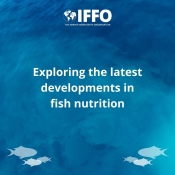 |
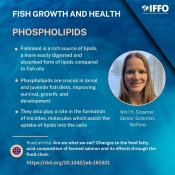 |
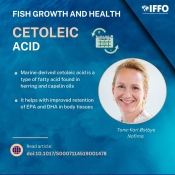 |
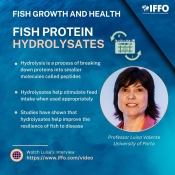 |
 |
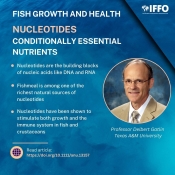 |
Krill meal
The Antarctic krill, Euphasia superba, is the raw material for krill oil (for direct human consumption) and krill meal (used in aquafeeds). Krill meal carries key nutrients, including essential amino acids, long-chain fatty acids, phospholipids, cholesterol and astaxanthin. It is an effective palatability enhancer for aquafeed, working as a strategic feed additive to aid intake, growth and health.
Benefits for humans
The benefits of consuming fish and fish oil supplements are well known and are very similar to the benefits to the fed fish. Just as fishmeal and fish oil play a vital role in the growth and health of farmed fish, these essential proteins, fats, minerals and vitamins are then passed onto humans. For humans, fish provides energy and is a superior source of protein to other animal source foods in terms of total protein and essential amino acid content and digestibility. Among other nutrients, farmed fish are a rich source of vitamin D and calcium (bone and muscle health), vitamin B12 (aids metabolism), Zinc and Selenium (aids immune system).
The other key nutrient for human health in marine ingredients are the long chain omega-3s (EPA and DHA), which are crucial for the health and growth of the farmed animals and in turn pass on the significant health benefits to us. Fish oil supplements are widely consumed with around 20% of the total fish oil produced in 2018 going to this growing industry. It is recommended that healthy adults consume a minimum of 250–500 mg combined EPA and DHA each day as part of a healthy diet.
|
For more information about EPA and DHA production, visit our research page For more information about human health visit GOED's Omega-3 website |








